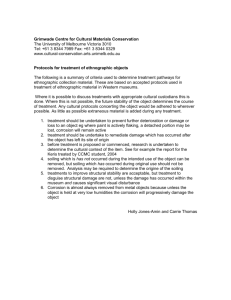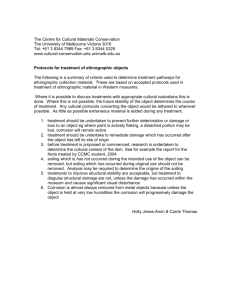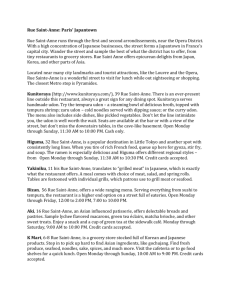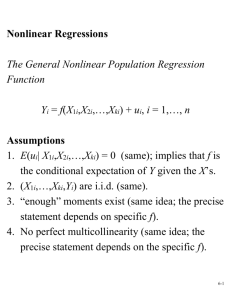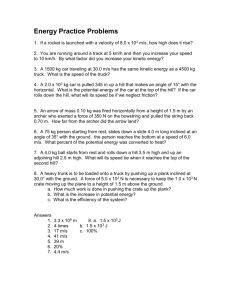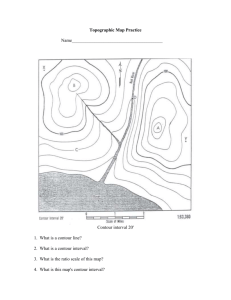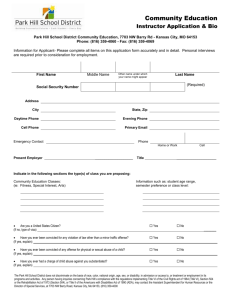79 Rue Hill West Chezzetcook, N.É., B0J 1N0 www
advertisement
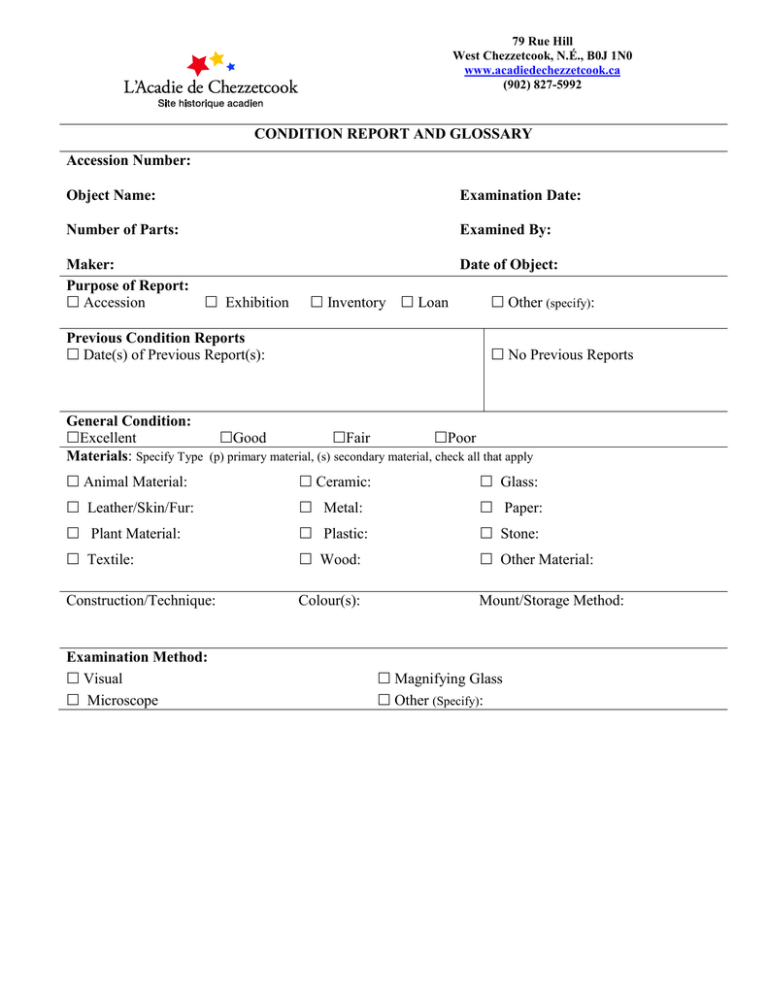
79 Rue Hill West Chezzetcook, N.É., B0J 1N0 www.acadiedechezzetcook.ca (902) 827-5992 CONDITION REPORT AND GLOSSARY Accession Number: Object Name: Examination Date: Number of Parts: Examined By: Maker: Purpose of Report: Accession Date of Object: Exhibition Inventory Loan Previous Condition Reports Date(s) of Previous Report(s): Other (specify): No Previous Reports General Condition: Excellent Good Fair Poor Materials: Specify Type (p) primary material, (s) secondary material, check all that apply Animal Material: Ceramic: Glass: Leather/Skin/Fur: Metal: Paper: Plant Material: Plastic: Stone: Textile: Wood: Other Material: Construction/Technique: Colour(s): Mount/Storage Method: Examination Method: Visual Microscope Magnifying Glass Other (Specify): 79 Rue Hill West Chezzetcook, N.É., B0J 1N0 www.acadiedechezzetcook.ca (902) 827-5992 Condition Description and Comments: Stable Unstable Specific Conditions (Indicate size and location): Alterations: Breaks: Brittle: Burns: Chips/Dents/Flakes: Corrosion: Cracks: Creases/Wrinkles: Discolouration/ Fading: Dust: Finger Prints: Fraying: Grime: Holes: Inherent Vice: Ingrained Dirt: Loose/Missing Parts: Number of Photographs Taken: Recommendations for Treatment: No Treatment Needed Treatment Need In-house: Active Deterioration Mould Active: Mould Residue: Mould Stains: Mildew: Pests Active: Pest Damage: Pest Residue: Residues: Rot: Scratches: Surface Soiling: Stains: Tears/Rips: Warping: Wear: Other: Photographs Uploaded to Database: Yes No 79 Rue Hill West Chezzetcook, N.É., B0J 1N0 www.acadiedechezzetcook.ca (902) 827-5992 Conservator: Monitor: Recommendations for Exhibition and Storage: Care and Handling: Environmental Conditions: Suggested Mounts: Other: Signature: Date: 79 Rue Hill West Chezzetcook, N.É., B0J 1N0 www.acadiedechezzetcook.ca (902) 827-5992 Condition Report Glossary Additions: Any pieces or parts that were added to the original artifact over the course of its history. Alterations: Changes made to the object over the course of its history that affect or change its appearance or function. Animal Material: Material (that is not skin, leather or fur) that came from an animal such as bone, ivory, shell and feathers. Breaks: A separation between areas of a hard material such as glass, ceramic, wood, stone and other materials, usually caused by a sudden shock and often occurring at weak points. May also be used to describe damage to brittle paper or cardboard, where pieces have been snapped off. Brittle: Loss of strength and flexibility, causing the material to break when bent. Paper is said to be brittle when a corner will not withstand two complete folds without breaking. Plastics also become brittle, through the loss of plasticizing agents. Burns: Surface damage caused by fire or heat. Burned surfaces are usually black or brown in colour, friable and brittle. There may also be soot and smoke damage, water damage and melting or softening. This term may also be used to describe damage caused by sunlight or chemical pollutants such as light or mat burn. Chips: Marks or flaws made by breaking off or gouging out of a small piece of the object. Corrosion: Gradual deterioration of a metal due to chemical processes such as oxidation or the action of a chemical agent. Some corrosion products, like metal patinas, can be protective; others, like rust, can be harmful. 79 Rue Hill West Chezzetcook, N.É., B0J 1N0 www.acadiedechezzetcook.ca (902) 827-5992 Cracks: Narrow openings between two parts of a material that have split or become broken but may not be separated from each other or suffered loss. Usually used to describe breaks in solid materials such as stone, ceramics and wood. In plastics, refers to splits that follow the grain or direction of manufacture. Creases/Wrinkles: Occur when a flat, sheet-like material such as paper or fabric has been folded over on itself. Dents: Hollows or depressions in the surface of the object, often caused by pressure or an impact. Discolouration: An overall change in the colour of a material, usually to a darker, more yellow or brown appearance. This may be caused by light damage or by exposure to acidic substances. Dust: Particulate material which has settled on the surface of the object and contributes to corrosion, staining and abrasion. Fading: Where a material becomes lighter in colour due to the action of various pollutants or light. Sunlight, especially the ultraviolet component, can be particularly damaging. Fingerprints: The impression of fingerprints left on an object, sometimes contributing to staining of the surface. Flakes: Small, thin pieces of varnish, paint or other layers that have become completely detached from the main support material, due to extreme cracking Fraying: Wearing away and/or unravelling of fabric, leaving loose threads General Condition: Excellent: object shows little or no modification due to age or wear 79 Rue Hill West Chezzetcook, N.É., B0J 1N0 www.acadiedechezzetcook.ca (902) 827-5992 Good: object shows minor modification due to age or wear Fair: object shows substantial modification due to age or wear Poor: object shows major modification due to age or wear Grime: Dirty or filthy matter adhering to or embedded in the surface of the object. Holes: Punctures or cavities in the object caused by a variety of means but were not part of the original object. Ingrained Dirt: Soiling that has been firmly worked or embedded into the material Inherent Vice: The tendency of material to deteriorate due to the essential instability of the components or interaction among components. Loose/Missing Part: Any element or piece of the object or image that is loose or missing Mould: Another word for fungi; mould spores can germinate and grow within organic materials to cause staining and structural weakening. May appear as colourful powdery or downy growth on an object’s surface, or as black spots. Mildew: Specific type of mould. It can be downy or powdery. Could be seen as yellow spots which then turn brown or a whitish powder that slowly turn yellowish brown and then black. Pests: Damage to objects caused by insects, rodents etc., usually through staining, soiling, and consuming surfaces and organic components. Evidence includes Pest Residue such as casings and frass (dust-like debris left by wood-eaters) and Pest Damage such as exit holes, and grazing (partially eaten surfaces). Plant Material: Cellulosed base material that is not wood, textile or paper, for instance grasses or reeds 79 Rue Hill West Chezzetcook, N.É., B0J 1N0 www.acadiedechezzetcook.ca (902) 827-5992 Residues: The remainder of a foreign substance on the object. Rot: the product of organic decomposition, sometimes seen in brown, white, or red particles on the object. Scratches: Breaks, mars, or marks on the surface of the object made by rubbing, scraping, or tearing with something sharp or rough Surface Soiling: Any material that dirties the surface of object Stains: A localized discolouration, often caused by splashes of liquid or by contact with an acidic material, such as an adhesive or ink. Tears/Rips: Separation between or across the fibres of canvas, paper or textile objects, usually beginning at the edge of the object and often following areas of weakness such as folds and initiated by physical damage. Warping: Results in changes to the object’s original dimensions; often occurs along lines of stress within the material. This tern is more often applied to wood and other more solid constructions than to thin materials such as paper. Wear: Gradual deterioration of the object’s surface by use or any continued process. Weakness: Loss of strength in the object that leaves it frail, fragile and liable to yield, break, or collapse under pressure or strain.
